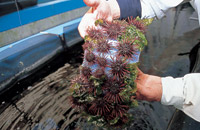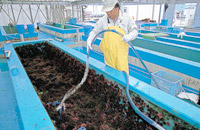|
Ensuring a regular supply of fish starts with clean seawater
Yellowtail fry about 1 cm in length are taken from the ocean, then placed in rearing tanks until they weigh a little more than 600 g each. Then they are moved to pens measuring about 10 m square. Fish farmers depend on their experience and technical skills when deciding how many yellowtail to put in the same pen—too many, and there's a risk of disease. The yellowtail used to be fed sardines when they were plentiful, but sardine catches went into decline around 1990, and today a composite feed made of fish meal is generally used.
Aquaculture offers the benefits of planned production and stable supply. Fish farms can supply large quantities on a regular basis, meaning lower prices for consumers.
Today, the main challenge facing producers is maintaining water quality in marine pens. The pens are located in bays because the water is calm, but the tidal flow is poor so uneaten feed and other wastes can build up and foul the water.
The Yusu Fisheries Cooperative in Uwajima, Ehime Prefecture, produces yellowtail and has also diversified into sea bream, flatfish and other species. Co-op members set out in boats once a month to remove garbage from coastal waters. The cooperative also asks people in neighboring communities to make sure water from their homes is not released into the sea, and to avoid using synthetic detergents. Producers in other parts of Japan are also showing greater determination in their efforts to protect the marine environment. 
|
 |


Top:Sea urchin at the Nagasaki Municipal Fisheries Center are fed seaweed, primarily sea lettuce and hijiki.
Center:In tanks, they grow to a diameter of about 1 cm in eight months or so.
Bottom:Then, about 300,000 to 400,000 of them are released at the same time into the ocean where there is a lot of seaweed, their favorite food.
|